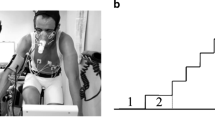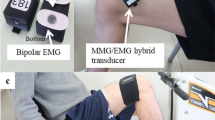Abstract
A new method for assessing the aerobic–anaerobic transition (AAT) in energy supply of exercise of a small- and large-muscle mass by the dynamics of the integrated electromyographic (EMG) activity indicators and changes in the content of deoxygenated hemoglobin (HHb) in the muscle tissue is proposed. Subjects performed two incremental exercise tests until exhaustion: the bicycle ergometer test and one-legged knee extension test. The dependence describing the change in the HHb content in m. vastus lateralis and its EMG activity during the test has a characteristic maximum, which corresponds to the AAT. Significant correlation (r = 0.78; p < 0.05) between the power at AAT and the power at the anaerobic threshold determined by the lactate concentration in capillary blood was found. It was shown that this method for determination of AAT is also suitable for determining the aerobic–anaerobic transition during the exercise of small-muscle mass.
Similar content being viewed by others
References
Popov, D.V., Netreba, A.I., Orlov, O.I., et al., Estimation of the functional state of the human body when solving problems of mass sports and sports of high achievements, in Nauka o sporte. Entsiklopediya sistem zhizneobespecheniya (Science about the Sport: Encyclopedia of Life Support Systems), UNESCO, 2011, p. 320.
Popov, D.V., Missina, S.S., Lemesheva, Yu.S., et al., Final blood lactate concentration after incremental test and aerobic performance, Human Phisiol., 2010, vol. 36, no. 3, p. 335.
Seluyanov, V.N., Podgotovka beguna na srednie distantsii (Training of a Middle-Distance Runner), Moscow: SportAkademPress, 2001.
Popov, D.V. and Vinogradova, O.L., Aerobic ability to work: the role of oxygen delivery, its utilization and activation of glycolysis, Usp. Fiziol. Nauk, 2012, vol. 43, no. 1, p. 30.
Popov, D.V., Vinogradova, O.L., and Grigor’ev, A.I., Aerobnaya rabotosposobnost’ cheloveka (Aerobic Human Ability to Work), Moscow: Nauka, 2012.
Lucía, A., Sánchez, O., Carvajal, A., and Chicharro, J.L., Analysis of the aerobic-anaerobic transition in elite cyclists during incremental exercise with the use of electromyography, Br. J. Sports Med., 1999, vol. 33, no. 3, p. 178.
Taylor, A.D. and Bronks, R., Electromyographic correlates of the transition from aerobic to anaerobic metabolism in treadmill running, Eur. J. Appl. Physiol. Occup. Physiol., 1994, vol. 69, no. 6, p. 508.
Taylor, A.D., Bronks, R., and Bryant, A.L., The relationship between electromyography and work intensity revisited: a brief review with references to lacticacidosis and hyperammonia, Electromyogr. Clin. Neurophysiol., 1997, vol. 37, no. 7, p. 387.
Rusko, H., Luhtanen, P., Rahkila, P., et al., Muscle metabolism, blood lactate and oxygen uptake in steady state exercise at aerobic and anaerobic thresholds, Eur. J. Appl. Physiol. Occup. Physiol., 1986, vol. 55, p. 181.
Beneke, R., Maximal lactate steady state concentration (MLSS): experimental and modelling approaches, Eur. J. Appl. Physiol., 2003, vol. 88, p. 361.
Faude, O., Kindermann, W., and Meyer, T., Lactate threshold concepts: how valid are they?, Sports Med., 2009, vol. 39, no. 6, p. 469.
Perry, S.R., Housh, T.J., Weir, J.P., et al., Mean power frequency and amplitude of the mechanomyographic and electromyographic signals during incremental cycle ergometry, J. Electromyogr. Kinesiol., 2001, vol. 11, no. 4, p. 299.
Karlsson, S. and Gerdle, B., Mean frequency and signal amplitude of the surface EMG of the quadriceps muscles increase with increasing torque—a study using the continuous wavelet transform, J. Electromyogr. Kinesiol., 2001, vol. 11, no. 2, p. 131.
Maughan, R.J., Greenhaff, P.L., Leiper, J.B., et al., Diet composition and the performance of high-intensity exercise, J. Sports Sci., 1997, vol. 15, no. 3, p. 265.
Brooks, G., Faher, T., White, T., and Baldwin, M., Exercise Physiology. Human Bioenergetics and Its Applications, McGraw-Hill, 1999.
Usaj, A., Kandare, F., and Starc, V., Changes in blood pH, lactate concentration and pulmonary ventilation during incremental testing protocol on cycle ergometer, Pfluegers Arch., 2000, vol. 439, no. 1 (suppl.), p. R220.
Author information
Authors and Affiliations
Corresponding author
Additional information
Original Russian Text © S.Yu. Kuznetsov, D.V. Popov, A.S. Borovik, O.L. Vinogradova, 2015, published in Fiziologiya Cheloveka, 2015, Vol. 41, No. 5, pp. 108–113.
Rights and permissions
About this article
Cite this article
Kuznetsov, S.Y., Popov, D.V., Borovik, A.S. et al. Determination of aerobic–anaerobic transition in the working muscle using EMG and near-infrared spectroscopy data. Hum Physiol 41, 548–552 (2015). https://doi.org/10.1134/S0362119715050096
Received:
Published:
Issue Date:
DOI: https://doi.org/10.1134/S0362119715050096




